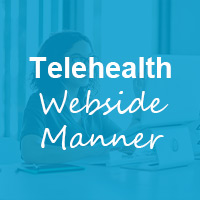Posted By Lauren Brawley On June 16, 2020
Telehealth Best Practices: Enhancing “Webside” Manner

Staying safe during the COVID-19 pandemic continues to increase the use of telehealth among healthcare professionals. 75% of individuals in the U.S. who have behavioral health conditions are continuing therapy services during COVID-19. Additionally, virtual care has increased 1.6x since the summer of 2019. And telehealth is here to stay. Convenience, access beyond clinical hours, and increased continuity of care are just a few of the key benefits in providing telehealth. With such an increase, we pulled together a list of best practices when conducting a telehealth appointment. Just as physicians focus on bedside manner during an in-person interaction, telehealth encounters have a proper “webside” manner.
Why is “Webside” Manner Important?
“Webside” manner is just as important as a regular bedside manner during client appointments. Webside manner is similar to bedside manner. It’s the way clinicians interact with patients during an appointment.
Studies show positive provider-patient relationships matter. When providers receive training in empathy, eye-contact, and other relationship-building strategies, health outcomes often improve. In other words, there are no negative side effects when you focus on maintaining a positive relationship with clients. Building a good rapport is crucial to providing meaningful care. So, how can you enhance your telehealth experience?
Best Practices for a Telehealth Encounter
Before the Appointment
If you are new to telehealth, we recommend practicing before your first client encounter. Even if you are experienced in telehealth, best practices are important reminders before each appointment. Here are a few items to consider:
- Have the correct equipment – Having a reliable computer or laptop with video functionality will be best for telehealth. Devices often perform best when plugged into a power source. Consider investing in a headset and a USB camera if your current technology isn’t up to par.
- Test your internet connection – Nothing can interfere with a patient encounter more than having poor communication. During a virtual appointment, internet connection can interfere with communication. Continually test your connectivity to ensure you provide the highest quality care. Placing the router close to your office helps improve wireless connections. If you can’t do that, consider getting a wireless range enhancer to boost your wifi signal.
- Physical space – When using video for telehealth, physical space determines whether a client can see you clearly. Proper lighting, for example, affects how well a client can see you. You may also consider a physical space that isn’t prone to unexpected sounds (from kids, pets, etc.). Additionally, make sure you are comfortable in the space before the appointment begins. Being intentional about your physical space decreases possible distractions.
- Practice – Grab a colleague to practice with. Set the stage just as you will during your appointments. Ask for feedback on how your space looks, whether the connection seems to be working properly, etc. For instance, a colleague may be able to comment on what the patient experience is like when logging into the telehealth appointment. Practice provides further confidence in using telehealth, which may be a new concept to you or your client.
- Have a back-up plan – It is no secret that technology can provide unexpected roadblocks. Whether it be a client’s internet giving out or a device losing power, know your backup plan. A backup plan may look like calling your patient instead of using video. Luckily telehealth compliance and reimbursement are flexible when issues do occur (some rules have become more relaxed during COVID-19). Your agency may provide you with a specific backup plan when things do not go as expected. Know the recommended procedure so you are prepared when challenges arise.
During the Appointment
It’s time for a telehealth appointment! After proper preparation, remember virtual communication best practices. Consider these tips:
- Focus on the camera to mimic eye contact.
- Be aware of body language.
- Stay seated when possible.
- Avoid distractions. This tip may seem obvious, but taping or fidgeting is often more distracting on video than in person.
- Be clear. Clarity on a virtual platform is critically important. For instance, ask clients if they can hear you okay. Ask clients if they need any clarification or have questions during each encounter. Being clear may seem like a simple communication practice, but double-checking your clients’ understanding is better than assuming they heard everything.
Your Reliable Solution
With telehealth on the rise, you need a reliable solution to continue providing meaningful care to your clients. That’s why Patagonia Health has developed an integrated telehealth solution. Our telehealth app allows users to easily integrate video appointments into their workflow. The solution is both secure and very easy to use. Interested in learning more? Contact us today.